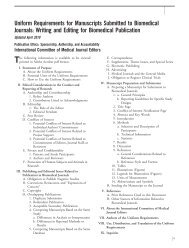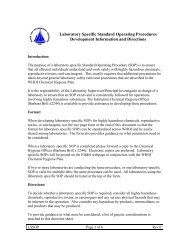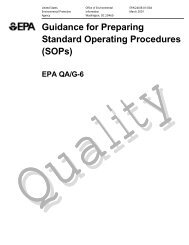Acrylamide in Baking Products: A Review Article
Acrylamide in Baking Products: A Review Article
Acrylamide in Baking Products: A Review Article
You also want an ePaper? Increase the reach of your titles
YUMPU automatically turns print PDFs into web optimized ePapers that Google loves.
540 Food Bioprocess Technol (2011) 4:530–543precursors might be a good <strong>in</strong>dex for evaluat<strong>in</strong>g processconditions <strong>in</strong>volved <strong>in</strong> acrylamide formation dur<strong>in</strong>g themanufacture of cereal products. For <strong>in</strong>stance, determ<strong>in</strong>ationof furos<strong>in</strong>e (∈-N-(furoyl-methyl)-L-lys<strong>in</strong>e) and HMF hasbeen used as an <strong>in</strong>dicator to evaluate the heat effects<strong>in</strong>duced dur<strong>in</strong>g the manufacture of cereal products such assliced bread toast<strong>in</strong>g (Ramírez-Jiménez et al. 2000; Henleet al. 1995; Ramirez-Jimenez 1998).Furos<strong>in</strong>e am<strong>in</strong>o acid is formed dur<strong>in</strong>g the hydrolysis ofAmadori compounds, <strong>in</strong>clud<strong>in</strong>g fructosyl-lys<strong>in</strong>e, lactulosyllys<strong>in</strong>eand maltulosyl-lys<strong>in</strong>e, produced by the reaction of∈-am<strong>in</strong>o groups of lys<strong>in</strong>e with glucose, lactose and maltose,respectively (Erbersdobler and Hupe 1991). HMF is an<strong>in</strong>termediate product <strong>in</strong> Maillard reaction and is also formedfrom the degradation of sugars at high temperatures(Ramírez-Jiménez et al. 2000; Kroh 1994; Berg and VanBoekel 1994; Morales et al. 1997).Ramírez-Jiménez et al. (2000) used furos<strong>in</strong>e and HMFdeterm<strong>in</strong>ations as <strong>in</strong>dicators of brown<strong>in</strong>g reactions <strong>in</strong> breadto evaluate their usefulness <strong>in</strong> process control. Theyreported a l<strong>in</strong>ear correlation between HMF and colour<strong>in</strong>dex <strong>in</strong> different commercial breads, but no l<strong>in</strong>earcorrelation was found between furos<strong>in</strong>e/HMF and furos<strong>in</strong>e/bak<strong>in</strong>gtemperature. They found that when the watercontent of the bread samples was lower, a smaller extensionof the brown<strong>in</strong>g reaction happened and a lower colour wasobserved, as can be verified by the higher furos<strong>in</strong>e content(early stage <strong>in</strong>dicator) and the lower HMF value. In thecrust, higher bak<strong>in</strong>g times produced a greater extension ofthe Maillard reaction and, therefore, a degradation offuros<strong>in</strong>e. The study of toasted sliced bread showed thatfuros<strong>in</strong>e levels began to descend after the first 10 m<strong>in</strong> of thetoast<strong>in</strong>g process (Ramírez-Jiménez et al. 2000). From theabove results, it may be concluded that negative correlationsexist between furos<strong>in</strong>e and colour <strong>in</strong>dex and betweenfuros<strong>in</strong>e and acrylamide formation. Therefore, when furos<strong>in</strong>econtent beg<strong>in</strong>s to decrease <strong>in</strong> bread crust, acrylamidecan be expected to start form<strong>in</strong>g. This might be a useful<strong>in</strong>dicator for evaluat<strong>in</strong>g the effects of bak<strong>in</strong>g conditions onacrylamide formation.As regards HMF, it is shown that there should be a l<strong>in</strong>earcorrelation between HMF and acrylamide content <strong>in</strong> breadso that HMF determ<strong>in</strong>ation can be recommended as aquality control measure <strong>in</strong>stead of acrylamide determ<strong>in</strong>ation,which is much more difficult and expensive.Ruiz et al. (2004) identified the three brown<strong>in</strong>g<strong>in</strong>dicators, namely furos<strong>in</strong>e, HMF and glucosylisomaltol,to be used as a complex <strong>in</strong>dicator of utility for monitor<strong>in</strong>gthe process<strong>in</strong>g of pre-baked bread. They reported nodetectable furos<strong>in</strong>e <strong>in</strong> raw dough. However, they observedthat the early stages of Maillard reaction were favoureddur<strong>in</strong>g the pre-bak<strong>in</strong>g process (14–15 m<strong>in</strong> at 175 °C) sothat furos<strong>in</strong>e <strong>in</strong>creased <strong>in</strong> content throughout the processwhilst colour did not change when compared with theorig<strong>in</strong>al dough and no HMF could be detected <strong>in</strong> thepre-baked bread. Therefore, no acrylamide formationcould be expected. They also reported that furos<strong>in</strong>econt<strong>in</strong>ued to <strong>in</strong>crease after bak<strong>in</strong>g for 14 m<strong>in</strong> at 220 °C,but decl<strong>in</strong>ed after 30 m<strong>in</strong>. This is while the HMFcontent <strong>in</strong>creased for all bak<strong>in</strong>g times. Their results areconsistent with those by other authors (Ramírez-Jiménezet al. 2000; Ramirez-Jimenez 2001).It can be concluded that furos<strong>in</strong>e and HMF might be theuseful <strong>in</strong>dicators for the estimation of acrylamide formationdur<strong>in</strong>g the bread bak<strong>in</strong>g process.Conclusion<strong>Acrylamide</strong> is a non-volatile compound which is classifiedas “potentially carc<strong>in</strong>ogenic to humans”. Man can bedirectly exposed to it by consum<strong>in</strong>g heat-treated foods rich<strong>in</strong> carbohydrates, such as baked foods, or <strong>in</strong>directly throughcerta<strong>in</strong> packag<strong>in</strong>g materials. The recent risk characterizationof acrylamide concludes that the evidence of acrylamidepos<strong>in</strong>g a cancer risk for humans has been strengthened.Therefore, reduc<strong>in</strong>g the acrylamide formed <strong>in</strong> baked foodsis still a major concern.This paper provides an overview of acrylamideformation dur<strong>in</strong>g the bread mak<strong>in</strong>g process. Even thoughbak<strong>in</strong>g is by evidence an important step dur<strong>in</strong>g whichacrylamide is formed, several other parameters such asformulation, flour quality, fermentation conditions amongothers play their roles <strong>in</strong> its formation. The follow<strong>in</strong>ggeneralizations may be drawn from the literature cited <strong>in</strong>this review:There is a strong positive correlation between bak<strong>in</strong>gtemperature and time and acrylamide formation, whilstreplacement of reduc<strong>in</strong>g sugars with sucrose and the use offlours with a lower asparag<strong>in</strong>e content (<strong>in</strong> recipe) maydecrease the acrylamide content of baked foods. On theother hand, reduced pH <strong>in</strong> some recipes such as cookies hasan opposite effect.Chemical <strong>in</strong>dicators such as furos<strong>in</strong>e and HMF may beused for controll<strong>in</strong>g the acrylamide content <strong>in</strong> pre-bakedand fully baked products, respectively.F<strong>in</strong>ally, it is possible to reduce the acrylamide contentwhilst reta<strong>in</strong><strong>in</strong>g the sensory quality by either <strong>in</strong>troduc<strong>in</strong>gsteam <strong>in</strong> traditional bak<strong>in</strong>g or by us<strong>in</strong>g new alternativebak<strong>in</strong>g techniques. The experimental works showed that itis possible to reduce acrylamide content by 40% <strong>in</strong> whitebread by apply<strong>in</strong>g steam dur<strong>in</strong>g the f<strong>in</strong>al 5 m<strong>in</strong> of bak<strong>in</strong>gwith no significant changes <strong>in</strong> the sensory quality. Also,us<strong>in</strong>g <strong>in</strong>frared radiation heat<strong>in</strong>g makes it possible to reducethe acrylamide level <strong>in</strong> flat bread cakes by 60% withreta<strong>in</strong>ed sensory properties.







